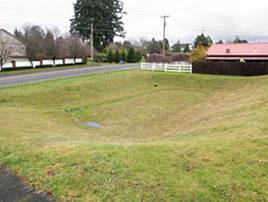
BMPs for stormwater infiltration
Best Management Practices that infiltrate stormwater runoff into underlying soil include, but are not limited, to
- infiltration basins,
- infiltration trenches,
- underground infiltration,
- bioinfiltration,
- permeable pavements, and
- tree trenches and tree boxes.
These are discussed briefly below.
Infiltration basin
| Applications | |
| Residential | yes |
| Commercial | Yes |
| Unltra-urban | Limited1 |
| Industrial | Yes2 |
| Highway/road | Limited |
| Recreational | Yes |
| Treatment capabilities3, 4, 5 | |
| TSS | High6 |
| TN | Medium/high |
| TP | Medium/high |
| Chloride | Low |
| Metals | High |
| Oils and grease | High |
| Pathogens | High |
1 Due to a size restriction
2 Unless the infiltration practice is located in an industrial area with exposed significant materials or from vehicle fuelling and maintenance areas. Infiltration BMPs are PROHIBITED in these areas.
3Underground infiltration systems will have different pollutant removal capabilities than what is provided in this table. These systems may have a wider application range, however, there is concern that they do not provide adequate treatment of the pollutants.
4 This is only for the portion of flow that enters the infiltration basin; by-passed runoff does not receive treatment.
5 Low = < 30%; Medium = 30-65%; High = 65 -100%)
6 Assumes adequate pre-treatment
An infiltration basin is a natural or constructed impoundment that captures, temporarily stores, and infiltrates a design volume of water.
